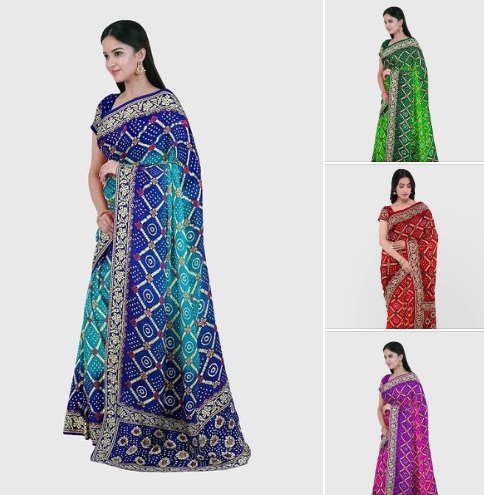Gujarati Bandhani sarees, celebrated for their vibrant colors and intricate tie-dye patterns, are not just garments; they are a canvas of cultural symbolism and artistic expression. These sarees tell stories, convey traditions, and carry a deeper meaning through the symbols and motifs that adorn them. In this blog, we take a closer look at Gujarati Bandhani sarees, exploring the symbolism, motifs, and the profound meaning behind this traditional art form.
- Bandhani: The Art of Tie-Dye:Bandhani, also known as Bandhej, is an ancient Indian textile art that involves tying fabric into small knots and then dyeing it. The word “Bandhani” is derived from the Sanskrit word “bandh,” which means to tie. The process results in beautiful patterns that have cultural significance.
- The Dot Motif: The most recognizable element of Gujarati Bandhani sarees is the dot motif. These dots are created by tying small sections of the fabric before dyeing it. The dots can vary in size and density, and they often form intricate patterns.
- Symbol of Good Luck: In Gujarati culture, the dot motif is considered a symbol of good luck and prosperity. It is believed to ward off evil spirits and bring positive energy to the wearer. The more intricate and dense the dot patterns, the more auspicious the saree is considered.
- Regional Variations: Different regions in Gujarat have their own unique Bandhani styles. For example, in Kutch, you will find Bandhani sarees with elaborate and colorful motifs, while in Jamnagar, the patterns may be more subtle and elegant.
- Geometric and Floral Motifs: In addition to dots, Gujarati Bandhani sarees often feature other geometric and floral motifs. These motifs may include flowers, leaves, peacocks, and more. Each motif carries its own cultural and symbolic significance.
- The Peacock Motif: The peacock is a revered motif in Bandhani sarees. In Indian culture, the peacock is associated with grace, beauty, and immortality. It represents love and the eternal bond between a husband and wife. Brides often wear Bandhani sarees with peacock motifs on their wedding day.
- The Elephant Motif: The elephant motif is another popular symbol in Bandhani sarees. Elephants are considered a symbol of strength, wisdom, and good fortune. They are often used to convey wishes for a prosperous and blessed life.
- Color Symbolism: The colors used in Bandhani sarees also carry meaning. Red, for instance, symbolizes love and marriage, while green represents fertility and new beginnings. Yellow is associated with happiness and prosperity, and blue is often used for its calming and soothing qualities.
- Occasion-Based Bandhani:Bandhani sarees are chosen based on the occasion. Bright and colorfulBandhani sarees are often worn during festive celebrations and weddings, while more subtle and elegant designs are chosen for formal gatherings and cultural events.
- Conclusion: A Cultural Tapestry: Gujarati Bandhani sarees are not just pieces of fabric; they are a cultural tapestry that weaves together symbols, motifs, and meaning. Wearing a Bandhani saree is not only a fashion statement but also a celebration of tradition, culture, and the rich heritage of Gujarat. It’s an acknowledgment of the artistry and craftsmanship that goes into creating these vibrant and meaningful pieces of clothing, connecting us to the past while embracing the present.






More Stories
Day to Night: Transitioning Your Women’s Leather Handbag for Different Occasions
The Ultimate Guide to Choosing and Decorating with Christmas Ornaments
Luxury Redefined: Premium Materials in High-End iPhone Case Collections